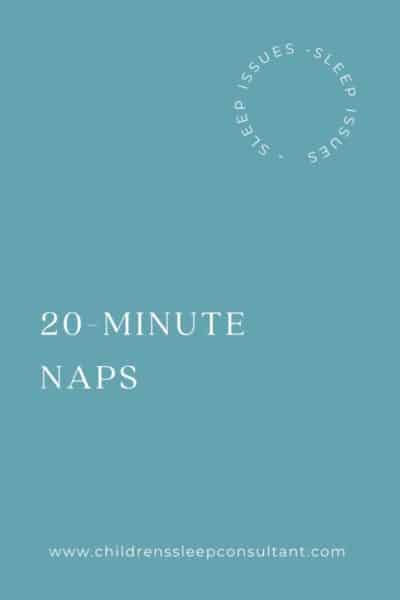
20-minute naps are very frustrating, aren’t they? You may spend longer getting your baby to fall asleep than they actually sleep!
It’s SO frustrating!
Luckily, I have a quick fix for you.
I know a 20-minute nap doesn’t sound like it needs much of an explanation. Your baby sleeps for 20 minutes! But there are a few characteristics of a 20-minute nap.
- Your baby will wake between 17 and 25 minutes after falling asleep or after they have been laid down (for example, if you help your baby fall asleep, hold them for 10 minutes after they have fallen asleep, lay them down, and they wake 20 minutes later, so it was 30 minutes after falling asleep)
- The wake-up is quick and urgent. They don’t gradually come into a light sleep and slowly wake.
- Your baby is loud! They are pretty mad pretty quickly.

Why does a 20-minute wake-up happen?
20-minute naps happen because your baby’s brain is overstimulated before they fall asleep. The overstimulation prevents your baby from going through an entire sleep cycle and wakes them quickly after just 20 minutes.
What to do when your baby wakes after 20 minutes.
Trying to help your baby get back to sleep after they have been sleeping for just 20 minutes can be impossible, and this is due to the reasoning behind the wake-up (more on that shortly). Of course, you can try to help them get back to sleep, but don’t try for too long. If they’re not falling back asleep, get them up and try to keep the play fairly calm and relaxed. Your baby is tired, and they may be a little grumpy (we’re all a little grumpy when we’re tired!), try to not to be overly stimulating as this will make the next nap much more challenging.
How to avoid another 20-minute nap
This is where my fix comes into play. Let’s see if we can prevent the 20-minute nap from happening again. Before you begin helping your child to sleep, you want to ensure their brain is relaxed. You can do this by having a 10 – 15 minute long nap routine. But, you will want to introduce what I call a walking wind-down before you begin this nap routine.
What is a walking wind-down?
Your walking wind-down should begin between 5 and 10 minutes before you plan on starting your nap routine. Scoop your baby up from whatever they were doing and walk around with them. Slowly walk around the house, looking out of the windows and pictures on the walk. The walk doesn’t need to be quiet, if there are older siblings, being, older siblings that’s okay. End your walking wind-down, where you will begin your nap routine.
The walking wind-down helps your child’s brain relax just a little more. The more relaxed your child is, the easier time they’ll have sleeping.
There are other times a walking wind-down can help your child’s brain relax.
Have you ever noticed your baby blankly staring at something? If so, this is their brain becoming overstimulated. As they’re becoming overstimulated, they can’t look away! If you see this, you can spend a minute or two doing a walking wind-down and then get back to playing. The wind-down midway through your awake time ensures their brain is not as overly stimulated before your nap, and you won’t need to spend as long winding down before you begin the nap routine.





